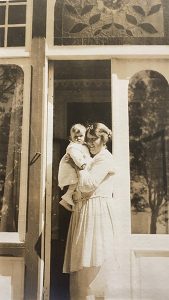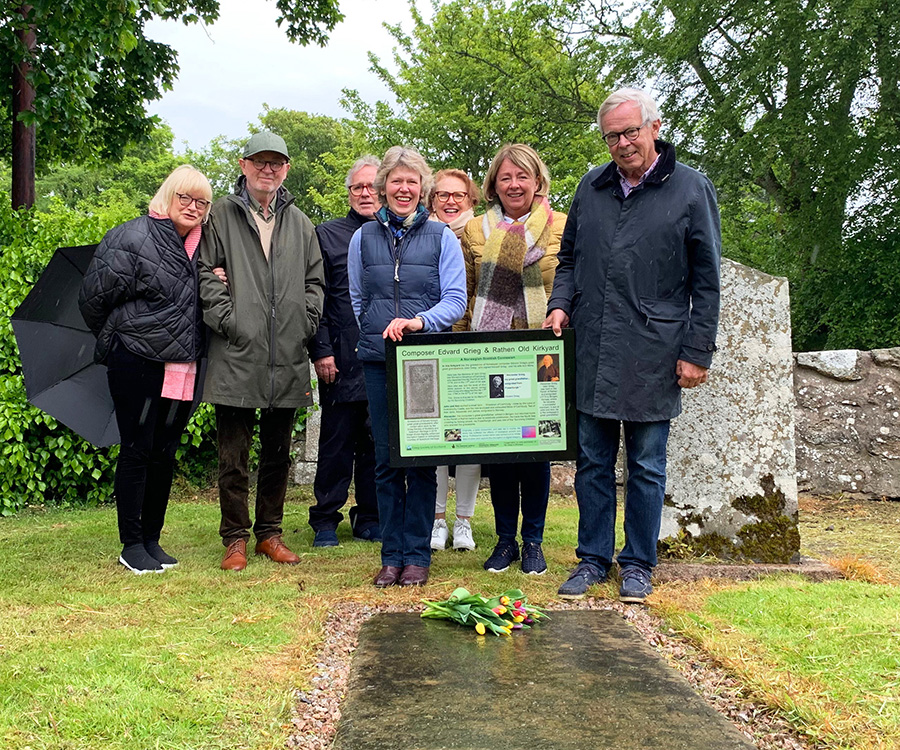When Joachim Hvide Grieg and friends flew from Bergen to begin a short holiday in North East Scotland in spring 2019, little did they anticipate their few days’ trip would turn into a touching ancestral tour for Joachim. We asked our Honorary President, journalist and editor Johanne Grieg Kippenbroeck, to catch up with Joachim on his return to Norway. Here are a few excerpts from her fascinating article (first published in Norwegian, in Troldposten n2 2019 Bergen) which you can also read in full (på norsk) here.


When it comes to Troldhaugen, Joachim Hvide Grieg isn’t just any ordinary Grieg. Had Nina and Edvard Grieg in their time made Troldhaugen suitable for winter residence, then it’s quite possible to imagine he might have grown up there. Though, that’s not how things turned out.
In December 1918 ‘our’ Joachim’s great-grandfather, Consul Joachim Grieg, bought Troldhaugen from Nina Grieg, who at that time no longer had the means to keep the house – Bergen town council had said ‘no thanks’ to an offer to take over the home as a museum.
The Consul thought Troldhaugen might make a suitable home for his son Einar and family, and this pleased Nina, who was delighted to sell to a Grieg, ensuring as it did that Griegs would continue to live at Troldhaugen.
When the sale became a reality, Nina wrote to the Consul, Edvard’s second cousin, thanking him for taking it over, and hoping that his son would be ‘as fond of the place as we were’ and not sell it again, which, she added ‘I have no desire to experience’.

Demolition plans
Two winters at Troldhaugen were, however, two winters too many for the family with their small children. The house proved unsuitable as an all-year-round home. Something Nina, of course, could have told them from the outset.
To make a long story short: plans were made to tear down the old wooden house and build a luxury villa designed by the well-known Bergen architect, Ole Landmark. Something, Nina probably never imagined.
But now the folk of Bergen woke up. There was a stooshie when it was learnt that the wooden villa was to be demolished, so that in the end, the Consul, who had given Nina a considerable sum for the residence, decided instead to donate Troldhaugen to Fana district council [Fana, a district of Bergen]. The Consul’s only condition for the gift was that Troldhaugen should be dedicated to the memory of Edvard and Nina Grieg.
Thus in 1928 the home was opened as a museum.
The VIP in the drawing-room
And this is how it came to be that the now 70-year old Joachim Hvide Grieg never lived at Troldhaugen. That he can’t be counted amongst its frequent visitors, either, is perhaps due to an early memory. As a youngster, he was privileged to attend, with his grandmother, a concert in the Villa, where, as the VIPs in the room they sat in the middle of the sofa in the drawing-room.
‘I remember, as a wee lad, sitting there listening to a lady who screamed in front of us’, he says with laughter. ‘I thought it was awful! Later on we went down to the grave site, and then grannie told me that grandfather had built the jetty down there. He was interested in boats and wanted to have a place to moor them. She told me all about how things were when they lived at Troldhaugen’.
Today he laughs at the memories from the concert experience, and has to confess that Grieg’s music still isn’t top of the list for him.
Last Grieg at Troldhaugen

Joachim paints a picture of his grandfather, Einar, and his father, Joachim, as two unusual, somewhat eccentric characters. ‘Grandfather was rich and knew how to spend money. Father was very unusual. In his later years he wanted to take a friend to the [Bergen] Festival, and sought tickets to the opening- and closing concerts’.
‘You can just forget about that’, came the message. ‘Everything is sold out’!
It was then Joachim’s father played his ace card: ‘I am the last Grieg to have lived at Troldhaugen’, he announced with weighty tone. And suddenly, out of thin air, came the tickets!
So there we have it – Joachim Hvide Grieg’s father, Joachim, was actually the last Grieg ever to live in the old house.

His son, so far, has not had any overwhelming interest for that bit of the family history. But, even so, he is the proud owner of his father’s kilt, tweed jacket, and sgian dhu. Rathen, though, has probably not been top of his wish list for places to visit until this spring, when he and his wife Gerd planned their travel with friends to Scotland. Then, of course, it was natural to include a trip to Fraserburgh and the nearby heritage-listed kirkyard at Rathen, where Edvard Grieg’s great-great-grandparents Anne Milne and John Greig lie buried.
Emotional meeting with the past
It was on a day of pouring rain, in May, when Gerd and Joachim Grieg were welcomed to Rathen by Dr Sally Garden of the Grieg Society of Scotland. They had brought tulips with them to lay at the grave of Joachim’s distant Grieg ancestors.
‘I thought it might be interesting to visit, but had never before been especially curious’, he admits. ‘It was really quite touching standing by this grave. The rain was pelting down, but it didn’t matter. Sally made it all very moving, she was so clued up about our family’.
And perhaps, there, in that moment, too, Joachim felt more keenly his distant blood ties. Even if music in the Villa still isn’t his first choice!

Author : Translated and adapted from an article by Johanne Grieg Kippenbroeck first published in Troldposten (n2 2019 Bergen)
